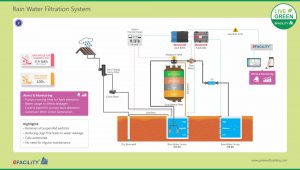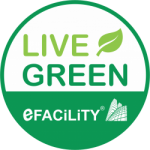 Rainwater harvesting is probably one of the best concepts that lets us gainfully use natural rainwater, which would otherwise go waste. Especially in areas that are dense with concrete buildings, the rainwater that falls flows away and is lost forever. That is why it is important for even the smallest of buildings to have in place a rainwater harvesting system that can provide a steady source of water, which can be filtered and re-filtered to make it potable enough for human consumption. Apart from being used in the restrooms and for watering the garden, the harvested rainwater can be purified using simple techniques to make it safe enough to drink.
Rainwater harvesting is probably one of the best concepts that lets us gainfully use natural rainwater, which would otherwise go waste. Especially in areas that are dense with concrete buildings, the rainwater that falls flows away and is lost forever. That is why it is important for even the smallest of buildings to have in place a rainwater harvesting system that can provide a steady source of water, which can be filtered and re-filtered to make it potable enough for human consumption. Apart from being used in the restrooms and for watering the garden, the harvested rainwater can be purified using simple techniques to make it safe enough to drink.
There are several types of rainwater harvesting systems used all over the world, with the cost depending on the size and the technology being deployed. However, all systems have one ultimate goal – to conserve rainwater and make best use of it. The advantage with rainwater harvesting is that it can be done at a very small scale as well as mammoth scales where several thousand liters of water is harvested.
The crudest form of rainwater harvesting is probably one where the larger particles of dust are filtered using a net and the rainwater is drawn through a pipe that fills up an underground sump with rainwater, which is pumped to water the garden.
A more sophisticated version is the domestic rainwater harvesting system where after the first net filter; the water is passed through a sand filter that removes other finer particles of dust/dirt. Even this water is not completely particle-free, though the water can be used for flushing and gardening purposes. Both these systems work on gravity feed systems, with no power being used to run motors to collect the water. However, electric pumps are used to pump the filtered water to an overhead storage tank.
A more elaborate and scientific system of rainwater harvesting is adopted in commercial buildings that have a large catchment area and the building is several floors high. The height of the building is an advantage as the water gains sufficient pressure and can be filled in strategically placed sumps without having to use electric pumps.
From a green building point of view, it is even more important to save every drop of rainwater and use it judiciously, thus contributing to energy conservation (read consuming less power as no pumps need to run) Here, at our 2nd greenest rated building in the world, all the rainwater from the roof is harvested, filtered, stored and filtered and utilized for flushing in the restrooms and for watering the garden. The rainwater harvested is first passed through “Rainy Filter“, which works based on natural flow (gravity and natural water pressure), thus helping save a lot of energy.
It automatically segregates the heavier dirt and is further collected in a desilting chamber and then stored in a large rainwater sump. This water is automatically pumped and filtered using a dual-media filter and UV filter and then goes to the raw water sump where it gets mixed the raw water either purchased or supplied by the municipal corporation. This water is again filtered using a pressure sand filter and an activated carbon filter and goes through another UV filter, which ensures the purity of the water, enabling it to be used for drinking purposes as well.
